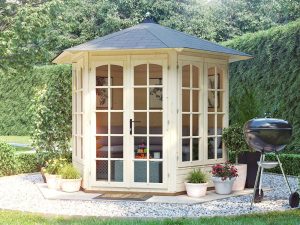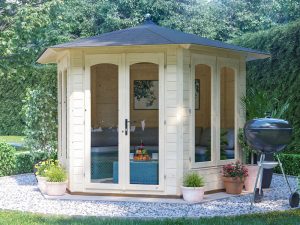Spray Test
If you need to check whether it’s time to re-apply a treatment, spray a bit of water onto your log cabin exterior and see what happens. If the water beads up and rolls down the surface without seeping into the wood, you’re all right for another year; if the water soaks into the wood, you’ll need to apply a fresh treatment coat.
Be sure to check the corners and ends of the logs as well; even if most of the surface is still resistant, the sides might be absorbing more moisture.
Cleaning and Maintaining
In the vast majority of cases, you will need to clean your log cabin before re-applying treatment. If the mud build-up isn’t too severe, you can clean it by hand. However, if you deem the cabin to be very dirty, then you may need to pressure clean it before applying a fresh coat of stain.
If the log cabin is in a worse state still, for example, the stain used in the last treatment is peeling extensively, you may want to consider preparing the logs for re-staining by restoring them to their original state through blasting. This process can be performed professionally either through corn cob blasting, power washing, or chemical stripping and is ideal for ensuring that the stain will soak in properly.
Looking out for Rain Damage and Leaks
During the cleaning process, it is useful to note where the dirt splatters and rain spots have built up on the walls and take note of where this may be causing damage. You should be taking measures to protect your cabin against the elements in these areas.
For this, you may need to apply waterproof silicone sealant (available from DIY stores), although you should only use this after re-applying treatment to your cabin.
Common problem areas include the joints around the windows and doors, the interlocking corners from under the roof to the foundations, and any visible gaps on the end of the logs.
Please note: For anyone interested in purchasing additional treatment for their garden building from Dunster House, please see the optional extras available for your specific product.
Find out more about how to maintain your garden building with our guide to wood treatment.








